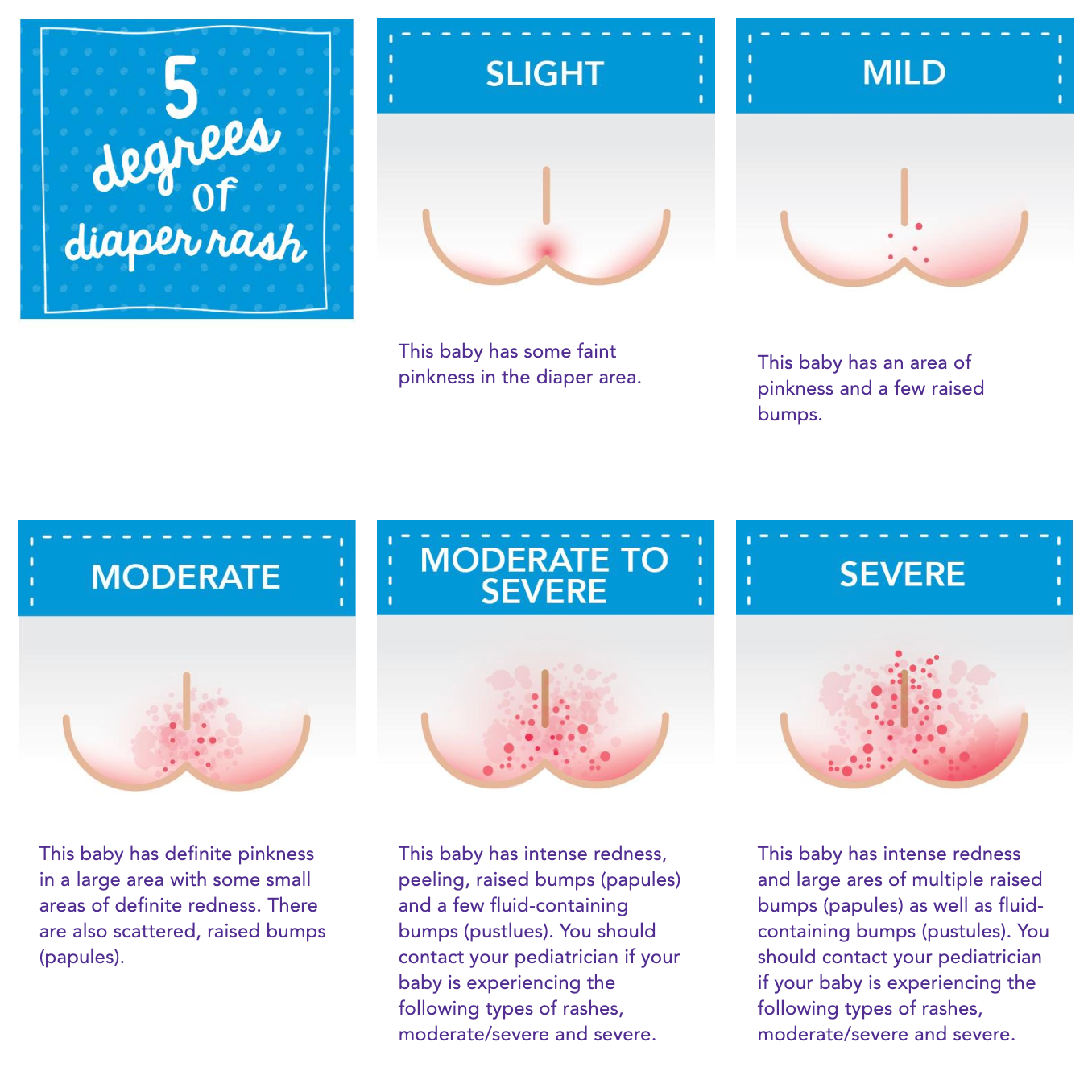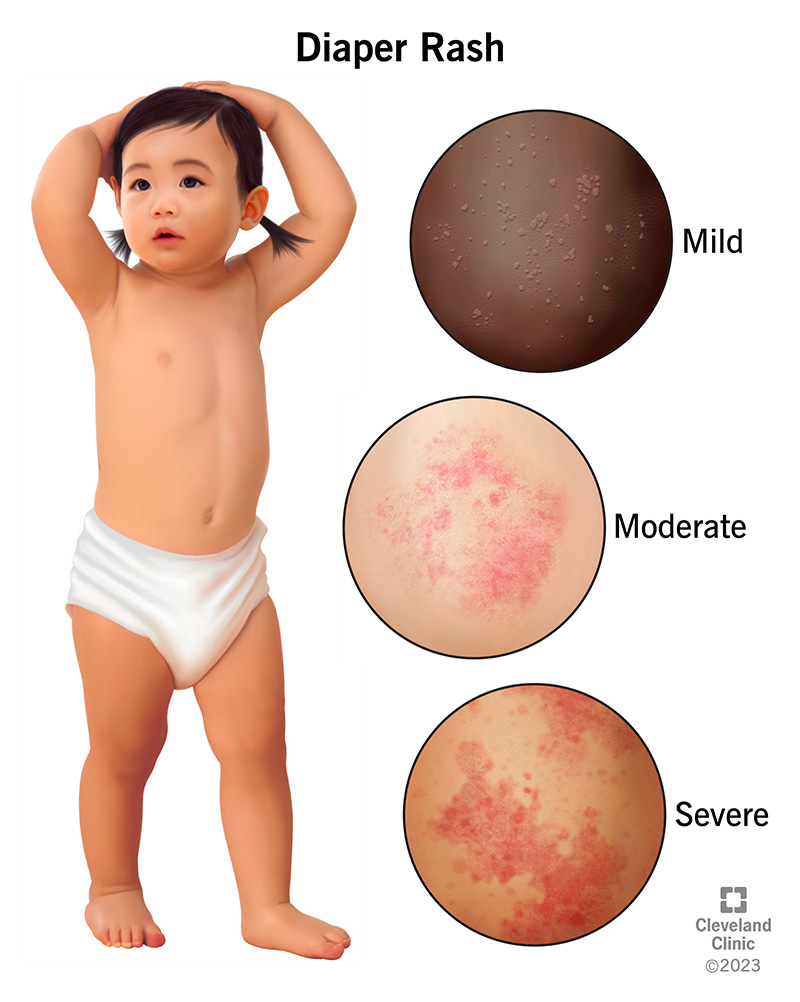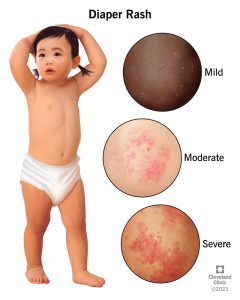Staph diaper rash is a skin condition caused by Staphylococcus bacteria that results in a rash in the diaper area. This rash is characterized by redness, bumps, and blisters, and can be itchy and painful for the baby.

Causes, Diaper rash
Staph diaper rash can occur due to various causes, such as the presence of Staphylococcus bacteria and skin barrier damage. Understanding these causes is crucial in preventing and managing this uncomfortable condition.
Staphylococcus Bacteria
The presence of Staphylococcus bacteria on the skin can contribute to the development of diaper rash. Staphylococcus aureus is the most common type of bacteria associated with this condition. This bacterium naturally resides on the skin and can thrive in warm, moist environments, making the diaper area an ideal breeding ground. When the delicate balance of bacteria on the skin is disrupted, the overgrowth of Staphylococcus can cause irritation, inflammation, and infection, leading to a staph diaper rash.
Staphylococcus bacteria can enter the diaper area through various means, including improper hygiene practices, contaminated diapers or wipes, and contact with infected individuals. It is also worth noting that prolonged antibiotic use can potentially disrupt the natural balance of bacteria on the skin, increasing the likelihood of a staph diaper rash.
Skin Barrier Damage
The skin serves as a protective barrier against irritants, moisture, and microorganisms. However, when the delicate skin in the diaper area becomes damaged or weakened, it becomes more susceptible to infection and irritation. Several factors can contribute to skin barrier damage, including:
- Prolonged exposure to moisture: Excessive moisture from urine or feces can strip away the natural protective oils of the skin, making it more prone to irritation and infection.
- Frequent diaper changes: Infrequent or delayed diaper changes can allow urine and feces to remain in contact with the skin for extended periods, leading to skin breakdown.
- Rubbing and friction: Friction caused by tight diapers or rough wiping can damage the delicate skin, increasing the risk of a staph diaper rash.
- Chemical irritants: Harsh soaps, detergents, and diaper creams containing chemicals or fragrances can irritate the skin, making it more susceptible to inflammation and infection.
It is important to maintain a healthy skin barrier in the diaper area by keeping it clean, dry, and well-moisturized. Regular diaper changes, gentle cleansing with mild soap and water, and the application of a barrier cream can help protect the skin and prevent the occurrence of Staph diaper rash.

Diagnosis
Diagnosing staph diaper rash is an important step in providing effective treatment for the condition. Healthcare providers typically use a combination of physical examination and lab tests to confirm the presence of a staph infection on a baby’s skin.
Physical Examination
A healthcare provider will conduct a thorough physical examination of the affected diaper area, looking for specific signs and symptoms such as redness, swelling, and pustules. They may also inquire about the baby’s recent medical history and any previous diagnosis or treatment for diaper rash.
Lab Tests
If the physical examination raises suspicion of a staph infection, the healthcare provider may recommend laboratory tests to confirm the diagnosis. These may include swabbing the affected area to collect a sample for culture and sensitivity testing. This helps determine the specific type of bacteria present and its sensitivity to certain antibiotics, guiding treatment decisions.
Treatment Options
If your baby is suffering from a staph diaper rash, it’s important to explore the right treatment options to alleviate their discomfort. Prompt and appropriate treatment can help prevent the infection from spreading and promote faster healing.
Topical Antibiotics
One effective treatment option for staph diaper rash is the use of topical antibiotics. These medications are applied directly to the affected area of the skin. Topical antibiotics help to eliminate the staph bacteria causing the infection and reduce inflammation.
When using topical antibiotics, it’s essential to follow your pediatrician’s instructions carefully. Start by cleaning the affected area with mild soap and water. After patting the area dry, apply a thin layer of the prescribed antibiotic ointment or cream. Make sure to cover the entire rash, including the surrounding skin.
Key Points:
- Topical antibiotics are applied directly to the affected area.
- These medications eliminate staph bacteria and reduce inflammation.
- Follow your pediatrician’s instructions for application.
- Clean the area, dry it, and apply a thin layer of the prescribed ointment or cream.
Oral Medications
In more severe cases of staph diaper rash or when the infection has spread beyond the diaper area, oral medications may be necessary. These medications help to fight the bacteria internally and speed up the healing process.
Your pediatrician may prescribe oral antibiotics to treat the staph diaper rash. These antibiotics target the specific strain of staph bacteria causing the infection. It’s crucial to follow the prescribed dosage and complete the full course of treatment, even if the rash appears to have improved.
Remember:
- Oral medications are used for severe or widespread infections.
- They fight bacteria internally and promote faster healing.
- Always adhere to the prescribed dosage and complete the full course of treatment.
Consulting with your pediatrician is essential to determine the most appropriate treatment option for your baby’s staph diaper rash. They will evaluate the severity of the infection and consider your child’s overall health before prescribing the necessary medications.
In case you missed it:
If you haven’t already, make sure to read our previous post on symptoms and causes of staph diaper rash.

Prevention
Staph diaper rash can be prevented by following proper hygiene practices and ensuring frequent diaper changes. By taking proactive measures, you can minimize the risk of this uncomfortable condition for your little one.
Proper Hygiene Practices
Maintaining proper hygiene is essential to prevent staph diaper rash. Always wash your hands thoroughly with soap and water before and after changing your baby’s diaper. This simple practice helps to eliminate harmful bacteria and reduce the likelihood of infection.
Frequent Diaper Changes
Frequent diaper changes are crucial in preventing staph diaper rash. Regularly check your baby’s diaper and change it promptly when wet or soiled. This ensures that the skin remains clean and dry, reducing the risk of irritation and infection.
Complications
A staph diaper rash can lead to complications if not treated promptly. These can include cellulitis, impetigo, or even a staph infection spreading to other parts of the body. It’s important to seek medical attention and follow proper hygiene to prevent these potential complications.
Severity Of Infection
For staph diaper rash, the severity of infection can vary depending on the individual. In severe cases, the rash can lead to painful blisters and sores on the skin. If left untreated, the infection can spread rapidly, causing further complications.
Risk Of Recurrence
The risk of recurrence for staph diaper rash is a concern, as the bacteria can persist. Improper hygiene practices can increase the chances of the rash coming back. Regular cleaning and sanitization routines are crucial in preventing future episodes.
Home Remedies
Home Remedies:
Natural Remedies
Steer clear of harsh chemicals, opt for gentler natural remedies for soothing staph diaper rash.
- Applying coconut oil can aid in moisturizing and reducing inflammation.
- Aloe vera gel provides a cooling effect while promoting healing.
- Epsom salt baths can alleviate discomfort and aid in drying out the rash.
When To Seek Medical Help
If the rash persists despite home remedies or if the condition worsens, seek medical assistance.
How Do You Treat A Staph Diaper Rash?
To treat a staph diaper rash, clean the affected area gently with warm water and a mild soap. Pat dry and apply an over-the-counter antibiotic ointment. Keep the diaper area clean and dry, and change diapers frequently. If the rash worsens or doesn’t improve, seek medical attention.
Is It Strep Or Staph Diaper Rash?
Strep and staph diaper rashes have different causes and symptoms. Strep rash is caused by streptococcus bacteria, while staph rash is caused by staphylococcus bacteria. Proper diagnosis by a healthcare provider is essential for effective treatment.
What Does A Bacterial Infection Diaper Rash Look Like?
A bacterial infection diaper rash appears red, inflamed, and may have pustules or sores. It can spread beyond the diaper area.
How Do I Know If My Diaper Rash Is Fungal Or Bacterial?
Fungal diaper rashes are often red, fiery, and have distinct borders, while bacterial rashes are typically moist, weepy, and have red bumps. If unsure, consult with a doctor to diagnose and treat the rash properly. Regular diaper changes and using creams can also help prevent both types of rashes.
Conclusion
It’s crucial to recognize the signs and symptoms of staph diaper rash in order to promptly seek appropriate treatment. By maintaining good hygiene practices and ensuring frequent diaper changes, parents can effectively prevent the occurrence of this condition. Furthermore, consulting a healthcare professional is always advisable for accurate diagnosis and treatment recommendations.
Remember, early detection and intervention are key to keeping your little one happy and comfortable.





